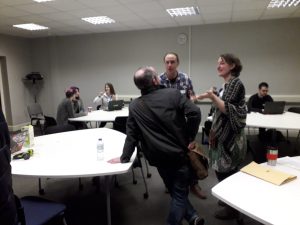
March 25, 2019, by Mathilde
Kayla Kemhadjian, First EBR Speaker – Wednesday 20 March
First Early Bird Research Seminar Speaker, Kayla Kemhadjian, PhD Student at the University of Leeds
We were delighted to receive Kayla Kemhadjian as one of our first speakers for 2019. Read this post for more information on the talk she gave on ‘Seventeen Self-Deaths: Interpreting Anglo-Saxon Perceptions of Suicide through Lexical Analysis’
Kayla Kemhadjian, a first year doctoral researcher at the University of Leeds, presented a talk entitled ‘Seventeen Self-Deaths: Interpreting Anglo-Saxon Perceptions of Suicide through Lexical Analysis’. In it, Kemhadjian walked through three methodologies she uses in her research in order to tease out cultural perceptions of self-killings in Anglo-Saxon England.
She began with a caution and explanation for the history of the term ‘suicide’ in modern and pre-modern English. Though the term may look as though it descends from classical Latin, it is actually a 17th century Latin neologism. Despite this, scholars still use the word to color their interpretation of pre-seventeenth century self-deaths. Moreover, the frequency of the term occurring as a transitive verb ‘to commit suicide’ was shown to highlight the unlawful connotation the word still has today. However, given that the term did not exist in the period under analysis, and given that self-killing was not yet illegal in England, Kemhadjian highlighted the anachronism and ethnocentrism that comes with its usage.
Kemhadjian then showcased the seventeen self-killing terms she has found in Old English which describe mostly violent self-deaths. She used etymology and sense relation to highlight their associative differences, explaining the difference between a self-murder (premeditated; unlawful; secret) and a self-stabbing (legal; public; with a sharp object).
After explaining the etymology of self-killing terms in Old English, Kemhadjian moved on to discuss how to tease out connotations and associations the words may not show in their etymological make up, but may contextually relate. In order to do so, Kemhadjian introduced the Natural Semantic Metalanguage, showcasing the usefulness of reductive paraphrase. She used a case study from The Fortunes of Men to suggest that one self-killing term was used similarly to ModE ‘overdose’, which would not be evident by etymological enquiry alone.
Finally, Kemhadjian introduced Conceptual Metaphor Theory as a way to reconstruct cultural myths and perceptions from the ground up. She showed how self-killing in Old English relates and relies on other conceptual metaphors like DEATH IS A JOURNEY, or SIN AS ILLNESS.
Ultimately, Kemhadjian highlighted that she has found that Anglo-Saxon self-killers were perceived to be sinful prior to the act of their self-death, which will be proven and explained in her forthcoming thesis on what we would dub mental health in Anglo-Saxon
England.
Kayla Kemhadjian
PhD Student | University of Leeds | Institute for Medieval Studies
site: ahc.leeds.ac.uk/history/pgr/1897/kayla-kemhadjian
email: hykyk@leeds.ac.uk
A few photos of Wednesday’s event will conclude this post.


No comments yet, fill out a comment to be the first

Leave a Reply